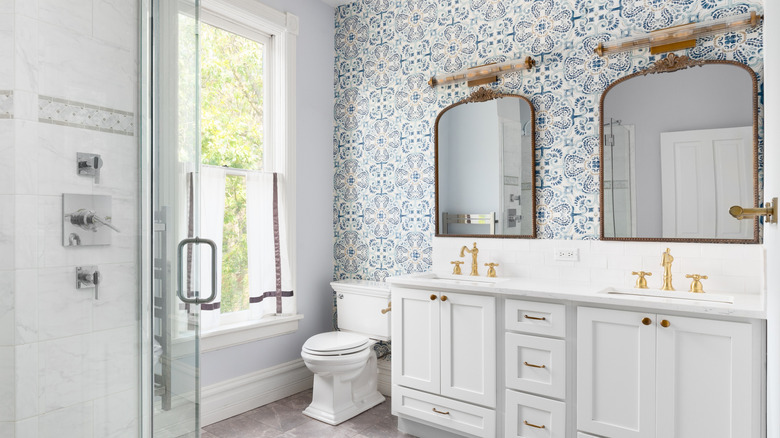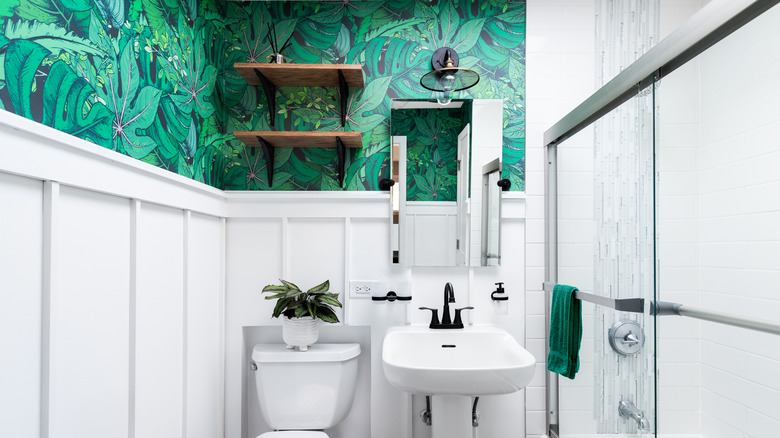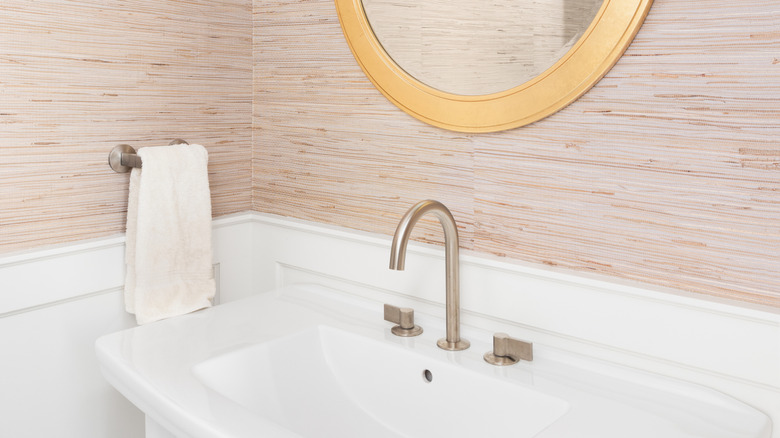The Trend That Makes Bathroom Wallpaper Less Intimidating
Bathrooms should evoke a sense of comfort and that feeling is best achieved in how the room is decorated. Many homeowners rely on wallpaper to add color to bathroom walls, but run the risk of picking a pattern that is too busy. An entire wall covered in wallpaper could make the room feel darker and more cramped. Not to mention trending styles go in and out of popularity quickly, so choosing a nontraditional design will likely require an update in a relatively short amount of time. If wallpaper feels too overwhelming on the entire wall, pair it with classic bathroom wainscoting to create the perfect balance.
Wainscoting is a decorative wall covering made up of wooden paneling, plywood, plastic, or a medium-density fiberboard (MDF) that cuts like wood. Its texture will add extra dimension to the space while complementing the smooth wallpaper. The timeless look of wainscoting panels has the ability to soften bold wallpaper and makes the bathroom feel symmetrical without compromising visual appeal. Utilizing contrasting materials is also a great way to optimize multiple design elements in a single space. Further, wainscoting draws the eye upward towards the ceiling, which causes the room to feel larger, making the most of a small bathroom. This also gives the wallpaper and the wainscoting ample room to shine without feeling like one is overpowering the other.
Wainscoting makes a stylish companion to bathroom wallpaper
When utilizing two different coverings on the walls, it can be challenging to know where to start. First, you must choose the right wallpaper for your space. If you are planning to lay the wallpaper yourself, consider DIY-friendly options such as peel-and-stick. This will cut down on time as the wallpaper and its adhesive backing will be applied to the wall simultaneously. Also, look at the colors that are currently in your bathroom and think about coordinating tones. Determine whether you want a pattern with large-scale details or smaller embellishments. It is also wise to pick a flat wallpaper rather than a textured one, as you won't want the design to feel like it is competing with the wainscoting below.
With wainscoting, there are various panel styles to choose from that differ based on look and construction, like flat panel, beaded panel, and raised panel. Flat panel boards are recessed, creating a simple, rectangular look. Beaded panel or beadboard has a shiplap design with vertical planks. The most luxurious is raised panel, which includes beveled edges in the middle of the panel to create a three-dimensional picture frame effect. Ideally, wainscoting should follow the visual rule of thirds and should be measured to cover the bottom third of a wall. Those wanting a larger scale design may choose to cover the bottom half or two-thirds of the wall.
Extra considerations for covering bathrooms walls with wallpaper and wainscoting
The combination of wallpaper and wainscoting is timeless and artistic while still being grounded. Making sure the two work hand and hand is the key to a seamless design. When picking out the style of your wainscoting and wallpaper duo, think about the surrounding items in the bathroom. Will wainscoting panels be placed below a window and need to look consistent in different forms of light? Is the wallpaper going next to the shower where it could possibly clash with the shower tile? Let these questions guide you to styles that are fitting for your space.
It may be easier to apply the wallpaper first since the wainscoting will require more attention to detail. When you are ready for wainscoting the bottom of the wall, floor trims and moldings need to be removed. The wallpaper atop and wainscoting below are divided by a molding, known as a "cap," to give the contrasting materials a finished look.
These bathroom installations need to be done correctly since this space is subject to so much water. Wainscoting made of wood may need to be treated with a waterproof barrier so it will not be damaged by splashes. Also, be sure to pick wallpaper that will not be damaged by shower humidity, like peel-and-stick vinyl, for example.


